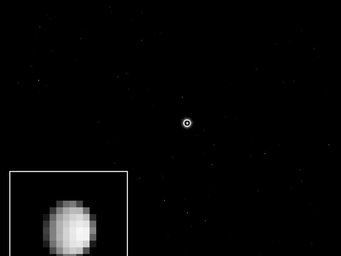First glance at a new world
NASA's Dawn spacecraft sends image of dwarf planet Ceres, to Earth
More than 413 million kilometers away from the warmth of the Sun, deep within the asteroid belt, a peculiar body travels along its orbit: Ceres, the largest asteroid in the solar system. With a diameter of about 950 kilometers and an almost spherical shape, Ceres seems more akin to a planet than an asteroid. In the spring of 2015, NASA's Dawn spacecraft will reach this mysterious world. Already now, from a distance of approximately 1.2 million kilometers, the Dawn Framing Camera has fixed its gaze at the mission's distant target. The final sprint to Ceres has begun.

The Dawn spacecraft is no newcomer to the asteroid belt. After its launch in September 2007, the spacecraft swung into orbit around the asteroid Vesta on 16 July 2011. For more than a year Dawn examined the body with a diameter of approximately 530 kilometers and found a world of bizarre beauty - with countless craters, deep grooves and one of the highest mountains in the solar system.
"Vesta is a rocky world with an inner structure similar to that of Earth”, says asteroid researcher Andreas Nathues from the Max Planck Institute for Solar System Research (MPS) in Germany, Framing Camera Lead Investigator. "During the second part of the mission to the asteroid Ceres, we will face vastly different conditions," he adds. Even though Vesta and Ceres both populate the asteroid belt, they are very different. Although much smaller, Vesta is in many ways comparable to the inner planets Mercury, Venus, Earth, and Mars. Some researchers actually refer to the body as the fifth member of this group. Ceres, however, is possibly more reminiscent of the icy moons of the outer planets Jupiter and Saturn: frozen and rich in water. Measurements with the Herschel Space Observatory suggest that Ceres occasionally spews water into space - similar to Saturn's moon Enceladus, but on a much smaller scale.
"The Dawn mission will help us understand how such wet asteroids formed and evolved and how they remain active today," says Dawn’s Principal Investigator Chris Russell from the University of California in Los Angeles. For this, Dawn’s camera system consisting of two identical instruments plays a crucial role. It was developed under the leadership of the MPS and is operated there. The Framing Cameras will not only map Ceres with a resolution of up to 35 meters, but also examine its topography and mineralogical composition.
In the first resolved image of Ceres, which was taken from a distance of approximately 1.2 million kilometers on 1 December 2014, the dwarf planet covers only nine pixels in diameter. The image will help the camera team to calibrate their instrument before arriving at Ceres in the next year. More highly resolved images will follow in the next months. "The sharpest image of Ceres available at this point was taken by the Hubble Space Telescope," said Nathues. "Our images should exceed this by the end of January. From then on, we enter uncharted territory.”
After a short approach phase, Dawn will swing into orbit around Ceres in March 2015. In the following months, the distance between the spacecraft and the surface will decrease to 400 kilometers. Dawn will accompany the new world for more than a year.
***********************
The Dawn mission to Vesta and Ceres is managed by NASA’s Jet Propulsion Laboratory for NASA's Science Mission Directorate (SMD), Washington. It is a project of the Discovery Program, managed for SMD by NASA's Marshall Space Flight Center, Huntsville, Ala. The University of California, Los Angeles, is responsible for overall Dawn mission science. Orbital Sciences Corporation of Dulles, Va., designed and built the Dawn spacecraft. The framing cameras have been developed and built under the leadership of the Max Planck Institute for Solar System Research, Göttingen, Germany, with significant contributions by the German Aerospace Center (DLR) Institute of Planetary Research, Berlin, and in coordination with the Institute of Computer and Communication Network Engineering, Braunschweig. The framing camera project is funded by the Max Planck Society, DLR, and NASA.
BK / HOR
